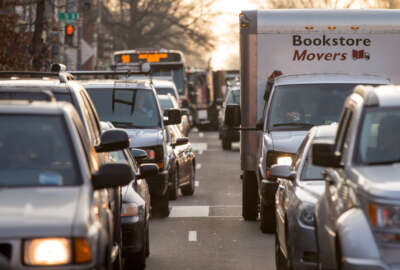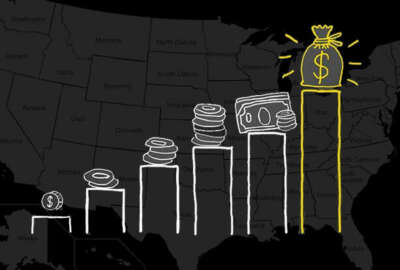
Life after coronavirus: Work from home, from anywhere — but take a locality pay cut?
Much of the federal workforce has spent the three months working from home. When work is about what you do, not where you do it, where does that leave locality pay?
A few days ago, your usual columnist posed a question: would you take a pay cut to work from home?
With your indulgence, I’ll take this hypothetical scenario one — perhaps major — step further. Would you forgo your usual locality pay adjustment to work from home, from anywhere in the United States?
Based on the comments, questions and often phone calls that we receive about this topic, locality pay is a Big Deal to many of you. And when locality pay adjustments contribute an additional few thousand dollars to your annual salaries, you bet it’s important.
Human capital experts have suggested this pandemic and the new remote work world could serve as a turning point for the way agencies recruit new federal employees. Why search for talent only in the Washington, D.C. metropolitan area if your employees could technically get the job done from anywhere?
If agencies did open up their recruiting pools to include prospective applicants from a broader geographic area, that could pose some tough questions about locality pay. Should you receive a D.C. salary if you’re not technically working in the nation’s capital, but your agency still has an office building there?
When work is about what you do, not where you do it, where does that leave locality pay?
Locality pay was born out of the 1990 Federal Employee Pay Comparability Act (FEPCA), which was originally designed to eliminate what economists had observed was a growing pay gap between non-federal and civil service salaries. The law authorizes the full amount necessary to reduce the pay gap between federal and non-federal salaries in 53 distinct locality pay areas. For reasons that are highly complicated, that doesn’t always pan out.
To be clear, it may not be feasible, or fair, to cut locality pay adjustments entirely out of the equation.
For example, a GS-12, step 5 in Washington, D.C., makes $97,848 in 2020, a salary that included a 2.6% increase in base pay this year, plus an additional 0.52% locality pay adjustment.
But without a locality adjustment, that same GS-12, step 5 is looking at base salary of $74,991 — a $22,857 difference.
But what if agencies offered this hypothetical remote employee a different locality pay rate, one that corresponded with the location of his or her home office and not the official work site in Washington?
A GS-12, step 5 in the “rest of U.S.” would make $86,952 in 2020 — that’s a $10,896 difference from the typical Washington salary.
The differences would be far less drastic for federal employees in other locality pay areas. This same GS-12, step 5 employee would make $94,519 in Philadelphia, a $3,329 difference from the Washington salary.
In Denver, this employee would earn $95,336, a $2,512 difference in salary. A Kansas-City-based employee would earn an annual salary of $87,837 in 2020, a $10,011 difference from the Washington pay rate.
These scenarios may be reasonable for fresh, future recruits to the federal government, but would you accept a locality pay change to work remotely — from anywhere?
Would you still live in the Washington, D.C. metro area, San Francisco, Boston or another expensive city even if the job doesn’t require you to be there?
For feds with family, children and lives in those cities, the answer may be yes. Moving may not be a desirable option.
For others, the perks of working from home are too desirable to pass up. A lower salary may not matter, with no commute, lunches out or dry cleaning.
It’s easy to dismiss all of the above as a crazy hypothetical that could never happen, and perhaps that’s true.
For one thing, it’s unclear whether agencies would embrace more flexible remote work options for their employees in the future, particularly as several organizations had cut back on their telework programs before the pandemic began.
Second, the 71-year-old General Schedule or the 30-year-old locality pay law weren’t built to respond to these hypothetical scenarios. Their creators probably never envisioned a future where feds could work a desk job based out of Washington from their kitchen tables in Charleston, South Carolina, or Rochester, New York.
Finally, this hypothetical isn’t even an option for many federal employees. There are plenty of jobs that require feds show up to a military base, a Federal Aviation Administration control tower or a veterans hospital and work in person. But many of these agencies are widespread, with offices and work sites at various places across the country.
Veterans Affairs Secretary Robert Wilkie attributed the department’s hiring successes during the pandemic, in part, because the agency allowed applicants to work at a location convenient to them.
But as a group of Chief Information Officers recently acknowledged, maybe it’s time agencies consider more remote work options.
“Not only do workers want to have collaborative and secure workplaces, their expectations of where they work are also changing,” they said. “With the ability to connect remotely across multiple places of work, individuals are seeking to perform work when and where they feel most comfortable.”
So where does that leave you? In a dream world, where would you work, and would you make a pay concession to get there?
Nearly Useless Factoid
Antarctica is considered a desert, with annual precipitation of 200 mm (7.9 in) along the coast and far less inland; there has been no rain there for almost 2 million years.
Source: Wikipedia
Copyright © 2025 Federal News Network. All rights reserved. This website is not intended for users located within the European Economic Area.
Nicole Ogrysko is a reporter for Federal News Network focusing on the federal workforce and federal pay and benefits.
Follow @nogryskoWFED





